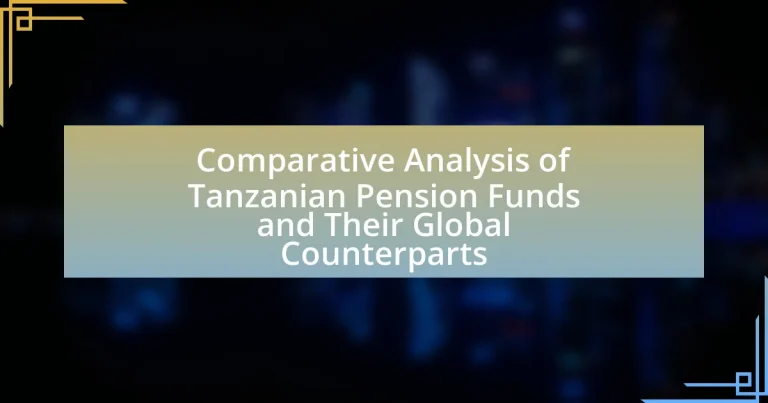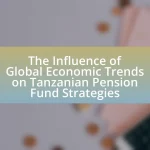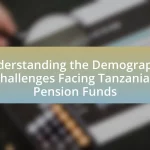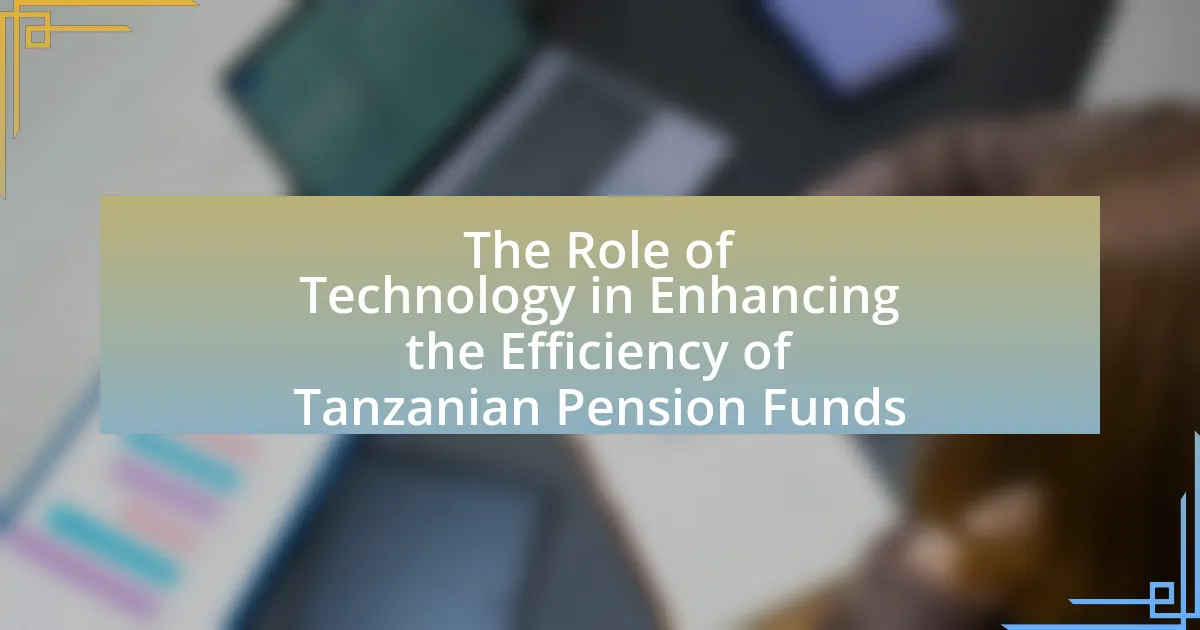Tanzanian pension funds are financial institutions managing retirement savings for workers in Tanzania, primarily governed by the National Pension Fund Act of 1997. This article provides a comparative analysis of Tanzanian pension funds and their global counterparts, highlighting key characteristics, structures, and regulatory frameworks. It examines the performance metrics of Tanzanian funds, the challenges they face, and the factors influencing their returns, while also discussing best practices and lessons that can be learned from global pension funds. Additionally, the article explores future trends, including the impact of technology and demographic changes on pension fund performance in Tanzania.

What are Tanzanian Pension Funds and How Do They Compare Globally?
Tanzanian pension funds are financial institutions that manage retirement savings for workers in Tanzania, primarily governed by the National Pension Fund Act of 1997. These funds are designed to provide income security for retirees and are characterized by a mix of defined benefit and defined contribution schemes. In comparison to global counterparts, Tanzanian pension funds face challenges such as lower coverage rates, with only about 10% of the workforce participating, compared to higher participation rates in developed countries, which often exceed 60%. Additionally, Tanzanian pension funds typically invest a significant portion of their assets in government securities, limiting diversification, whereas global pension funds often have broader investment strategies that include equities and alternative assets, enhancing potential returns.
What is the structure of Tanzanian Pension Funds?
The structure of Tanzanian Pension Funds consists of a mix of mandatory and voluntary schemes regulated by the National Social Security Fund (NSSF) and various other pension schemes. The NSSF is the primary institution managing mandatory contributions from employees in the formal sector, while additional private pension schemes cater to both formal and informal workers, allowing for voluntary contributions. As of 2021, the pension sector in Tanzania included over 30 registered pension funds, which collectively manage assets exceeding 5 trillion Tanzanian Shillings, reflecting the growing importance of retirement savings in the country’s economy.
What types of pension funds exist in Tanzania?
In Tanzania, there are primarily three types of pension funds: public pension funds, private pension funds, and occupational pension schemes. Public pension funds, such as the National Social Security Fund (NSSF) and the Public Service Pension Fund (PSPF), are established by the government to provide retirement benefits to public sector employees. Private pension funds are set up by private companies for their employees, while occupational pension schemes are created by employers for specific groups of workers, often within certain industries. These pension funds are regulated by the Pension Funds Act of 2008, which ensures their operation and management adhere to established standards.
How are Tanzanian pension funds regulated?
Tanzanian pension funds are regulated primarily by the Pension Funds Act of 2008, which establishes the legal framework for the operation and management of pension schemes in the country. The regulation is enforced by the Pension Fund Regulatory Authority (PPFRA), which oversees compliance with the Act, ensuring that pension funds operate in a transparent and accountable manner. The PPFRA also sets guidelines for investment strategies, fund management, and reporting requirements, thereby safeguarding the interests of pension fund members.
What are the key characteristics of global pension funds?
Global pension funds are characterized by their large asset bases, diversified investment portfolios, and long-term investment horizons. These funds typically manage trillions of dollars in assets, allowing them to invest across various asset classes, including equities, fixed income, real estate, and alternative investments. Their diversification helps mitigate risks and enhance returns over time. Additionally, global pension funds often have a fiduciary duty to act in the best interests of their beneficiaries, which drives their focus on sustainable and responsible investing practices. For instance, as of 2021, the total assets managed by global pension funds exceeded $40 trillion, highlighting their significant role in the global financial system.
How do global pension funds differ in structure and regulation?
Global pension funds differ in structure and regulation primarily due to variations in legal frameworks, funding mechanisms, and governance models across countries. For instance, in the United States, pension funds are often structured as defined benefit or defined contribution plans, regulated under the Employee Retirement Income Security Act (ERISA), which mandates minimum funding standards and fiduciary responsibilities. In contrast, European pension funds may follow different regulatory frameworks, such as the IORP II Directive, which emphasizes risk management and transparency. Additionally, some countries, like Canada, utilize a multi-employer pension plan structure that allows for collective investment and risk-sharing among various employers. These structural differences are influenced by local economic conditions, demographic factors, and cultural attitudes towards retirement savings, leading to diverse regulatory approaches that reflect each country’s priorities and challenges in pension fund management.
What investment strategies are commonly used by global pension funds?
Global pension funds commonly utilize diversified investment strategies, including asset allocation across equities, fixed income, real estate, and alternative investments. These strategies aim to balance risk and return while meeting long-term liabilities. For instance, according to the 2021 Global Pension Assets Study by Willis Towers Watson, the average allocation to equities was approximately 50%, while fixed income represented around 30%, and alternative investments accounted for about 20%. This diversification helps pension funds mitigate risks associated with market volatility and inflation, ensuring sustainable growth of their assets over time.
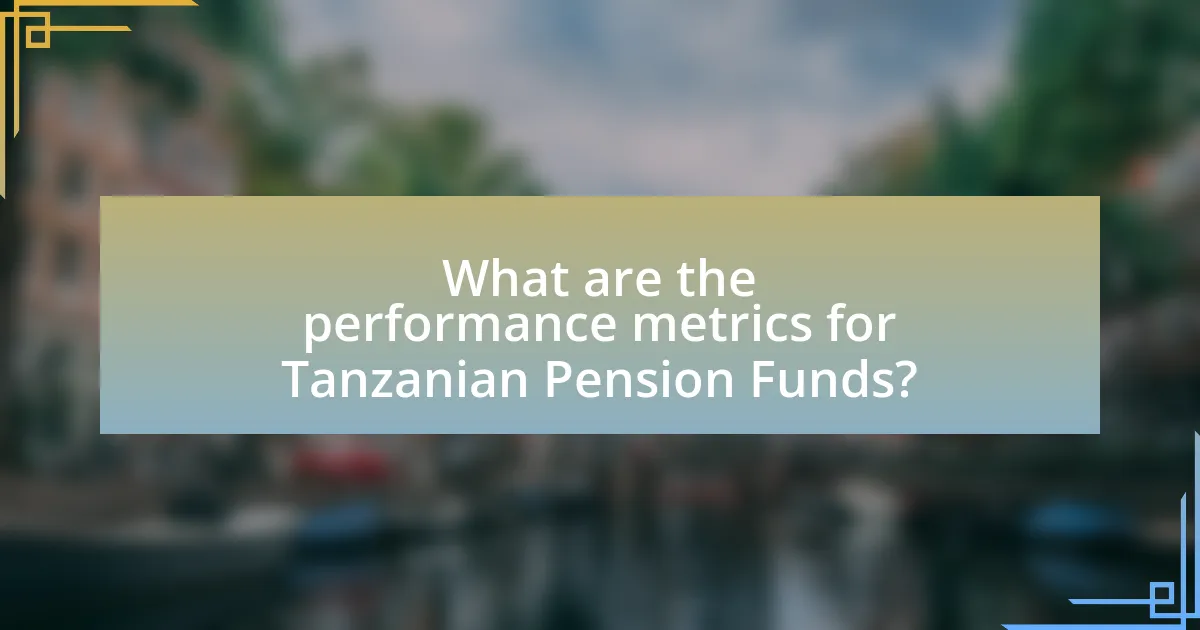
What are the performance metrics for Tanzanian Pension Funds?
The performance metrics for Tanzanian Pension Funds primarily include investment returns, funding ratios, and member growth rates. Investment returns are assessed based on the annualized rate of return on assets, which for Tanzanian pension funds has averaged around 8% over recent years. Funding ratios, which indicate the financial health of the funds, typically range from 70% to 90%, reflecting the proportion of liabilities covered by assets. Additionally, member growth rates have shown a steady increase, with the number of registered members rising by approximately 5% annually, indicating a growing participation in pension schemes. These metrics are crucial for evaluating the sustainability and effectiveness of pension funds in Tanzania.
How do Tanzanian pension funds perform compared to global benchmarks?
Tanzanian pension funds generally underperform compared to global benchmarks. For instance, a report by the World Bank in 2021 indicated that Tanzanian pension funds had an average annual return of approximately 6%, while global pension fund benchmarks, such as the MSCI World Index, reported average returns around 10% during the same period. This disparity highlights the challenges faced by Tanzanian pension funds, including limited investment options and regulatory constraints, which hinder their ability to achieve competitive returns on par with global standards.
What factors influence the performance of Tanzanian pension funds?
The performance of Tanzanian pension funds is influenced by several key factors, including regulatory frameworks, investment strategies, economic conditions, and demographic trends. Regulatory frameworks dictate the operational guidelines and investment limits for pension funds, impacting their ability to diversify and optimize returns. Investment strategies, such as asset allocation and risk management, directly affect the funds’ performance, with a focus on balancing growth and security. Economic conditions, including inflation rates and GDP growth, influence the overall investment environment, affecting returns on assets held by pension funds. Additionally, demographic trends, such as aging populations and workforce participation rates, shape the demand for pension benefits and the sustainability of pension systems. These factors collectively determine the effectiveness and efficiency of pension fund management in Tanzania.
How do investment returns of Tanzanian funds compare to those of global funds?
Investment returns of Tanzanian funds generally lag behind those of global funds. For instance, while Tanzanian pension funds have reported average annual returns of around 8% over the past decade, global funds, particularly those in developed markets, have achieved average returns exceeding 10% during the same period. This disparity can be attributed to factors such as market maturity, economic stability, and investment diversification opportunities available in global markets compared to Tanzania’s emerging market conditions.
What challenges do Tanzanian pension funds face?
Tanzanian pension funds face several significant challenges, including regulatory constraints, low investment returns, and limited financial literacy among members. Regulatory constraints hinder the ability of pension funds to diversify their investment portfolios, which can lead to suboptimal returns. Additionally, the average return on investments for Tanzanian pension funds has been reported to be lower than the inflation rate, eroding the purchasing power of retirees. Furthermore, many members lack adequate financial literacy, which affects their understanding of pension benefits and investment options, ultimately impacting their retirement planning. These challenges collectively undermine the effectiveness and sustainability of pension funds in Tanzania.
How do economic conditions in Tanzania impact pension fund performance?
Economic conditions in Tanzania significantly influence pension fund performance through factors such as inflation rates, economic growth, and regulatory frameworks. High inflation can erode the real value of pension fund assets, while robust economic growth can enhance investment returns and increase contributions. For instance, Tanzania’s GDP growth rate averaged around 6-7% in recent years, positively impacting the financial health of pension funds by increasing the pool of investable assets. Additionally, regulatory changes, such as the introduction of the National Pension Fund Act, have aimed to improve fund management and investment strategies, further affecting performance. These economic dynamics create a complex environment where pension funds must navigate challenges and opportunities to optimize returns for beneficiaries.
What are the risks associated with Tanzanian pension funds?
The risks associated with Tanzanian pension funds include market volatility, regulatory changes, and inadequate investment diversification. Market volatility can lead to significant fluctuations in fund values, impacting the retirement savings of beneficiaries. Regulatory changes, such as alterations in pension laws or tax policies, can affect fund management and returns. Additionally, inadequate investment diversification increases the risk of losses, as funds may be overly concentrated in specific sectors or asset classes, making them vulnerable to economic downturns. These factors collectively pose challenges to the stability and reliability of pension funds in Tanzania.

What lessons can Tanzanian Pension Funds learn from their global counterparts?
Tanzanian Pension Funds can learn the importance of diversification from their global counterparts. Global pension funds often allocate assets across various classes, such as equities, bonds, real estate, and alternative investments, to mitigate risks and enhance returns. For instance, the California Public Employees’ Retirement System (CalPERS) has successfully utilized a diversified investment strategy, which has historically led to more stable returns over time. Additionally, Tanzanian Pension Funds can adopt best practices in governance and transparency, as seen in the Netherlands, where pension funds are required to disclose their investment strategies and performance metrics, fostering accountability and trust among stakeholders. These lessons highlight the need for Tanzanian Pension Funds to implement robust investment strategies and governance frameworks to improve their overall performance and sustainability.
What best practices from global pension funds can be applied in Tanzania?
Best practices from global pension funds that can be applied in Tanzania include adopting diversified investment strategies, enhancing governance structures, and implementing robust risk management frameworks. Diversified investment strategies, as seen in funds like the Canada Pension Plan Investment Board, allow for risk mitigation and improved returns by spreading investments across various asset classes. Enhanced governance structures, exemplified by the Netherlands’ pension funds, ensure accountability and transparency, fostering trust among stakeholders. Additionally, robust risk management frameworks, similar to those employed by the AustralianSuper, help in identifying and mitigating potential financial risks, which is crucial for the sustainability of pension funds in Tanzania. These practices can significantly improve the efficiency and effectiveness of Tanzania’s pension system.
How can Tanzanian pension funds improve their investment strategies?
Tanzanian pension funds can improve their investment strategies by diversifying their portfolios to include a broader range of asset classes, such as equities, real estate, and infrastructure projects. This diversification can mitigate risks and enhance returns, as evidenced by global pension funds that have successfully adopted similar strategies. For instance, the California Public Employees’ Retirement System (CalPERS) has achieved higher returns through a diversified investment approach, which includes alternative investments that are less correlated with traditional asset classes. By learning from such global practices, Tanzanian pension funds can better align their investment strategies with those that have proven effective in other markets.
What governance structures can enhance the effectiveness of Tanzanian pension funds?
Effective governance structures for Tanzanian pension funds include a clear regulatory framework, independent oversight bodies, and stakeholder engagement mechanisms. A robust regulatory framework ensures compliance with laws and standards, while independent oversight bodies, such as boards of trustees, provide accountability and transparency in fund management. Stakeholder engagement mechanisms, including regular communication with members and beneficiaries, enhance trust and responsiveness to their needs. Research indicates that countries with strong governance frameworks, like those in OECD nations, experience better fund performance and member satisfaction, highlighting the importance of these structures in enhancing the effectiveness of pension funds in Tanzania.
What future trends should Tanzanian pension funds consider?
Tanzanian pension funds should consider the trend of increasing investment in technology-driven solutions to enhance operational efficiency and member engagement. The global shift towards digital platforms for managing pension assets and providing services is evident, with many funds adopting fintech innovations to streamline processes and improve user experience. For instance, a report by the World Bank highlights that digital financial services can significantly reduce transaction costs and improve access to financial products, which is crucial for pension fund sustainability in emerging markets like Tanzania. Additionally, the growing emphasis on sustainable investing, particularly in environmental, social, and governance (ESG) criteria, is reshaping investment strategies worldwide, and Tanzanian pension funds can benefit from aligning with these global standards to attract more investments and ensure long-term viability.
How is technology shaping the future of pension funds globally?
Technology is significantly shaping the future of pension funds globally by enhancing operational efficiency, improving data analytics, and facilitating better customer engagement. Automation and artificial intelligence streamline administrative processes, reducing costs and errors in fund management. For instance, a report by Deloitte highlights that automation can cut operational costs by up to 30%, allowing pension funds to allocate resources more effectively. Additionally, advanced data analytics enable pension funds to make informed investment decisions by analyzing market trends and member behavior, which can lead to improved returns. Furthermore, technology fosters better communication with members through digital platforms, enhancing transparency and trust. According to a survey by PwC, 75% of pension fund participants prefer digital interactions, indicating a shift towards technology-driven engagement.
What demographic changes will impact pension funds in Tanzania?
Demographic changes such as an aging population, urbanization, and declining fertility rates will significantly impact pension funds in Tanzania. The aging population increases the number of retirees, leading to higher payouts from pension funds, while urbanization shifts labor patterns and may affect contributions. Additionally, declining fertility rates result in a smaller working-age population, which can reduce the ratio of contributors to beneficiaries, putting further strain on pension systems. These trends are supported by data from the National Bureau of Statistics, which indicates that the proportion of the population aged 60 and above is projected to rise, thereby increasing the financial burden on pension funds.
What practical steps can Tanzanian pension funds take to enhance their performance?
Tanzanian pension funds can enhance their performance by diversifying their investment portfolios to include a mix of domestic and international assets. This strategy allows for risk mitigation and potential higher returns, as evidenced by global trends where diversified funds often outperform those with concentrated investments. Additionally, adopting advanced technology for data analysis and investment management can improve decision-making processes, leading to better investment outcomes. Research indicates that funds utilizing technology-driven analytics have seen performance improvements of up to 20%. Furthermore, increasing transparency and governance standards can build trust with stakeholders, which is crucial for attracting more contributions and investments.
